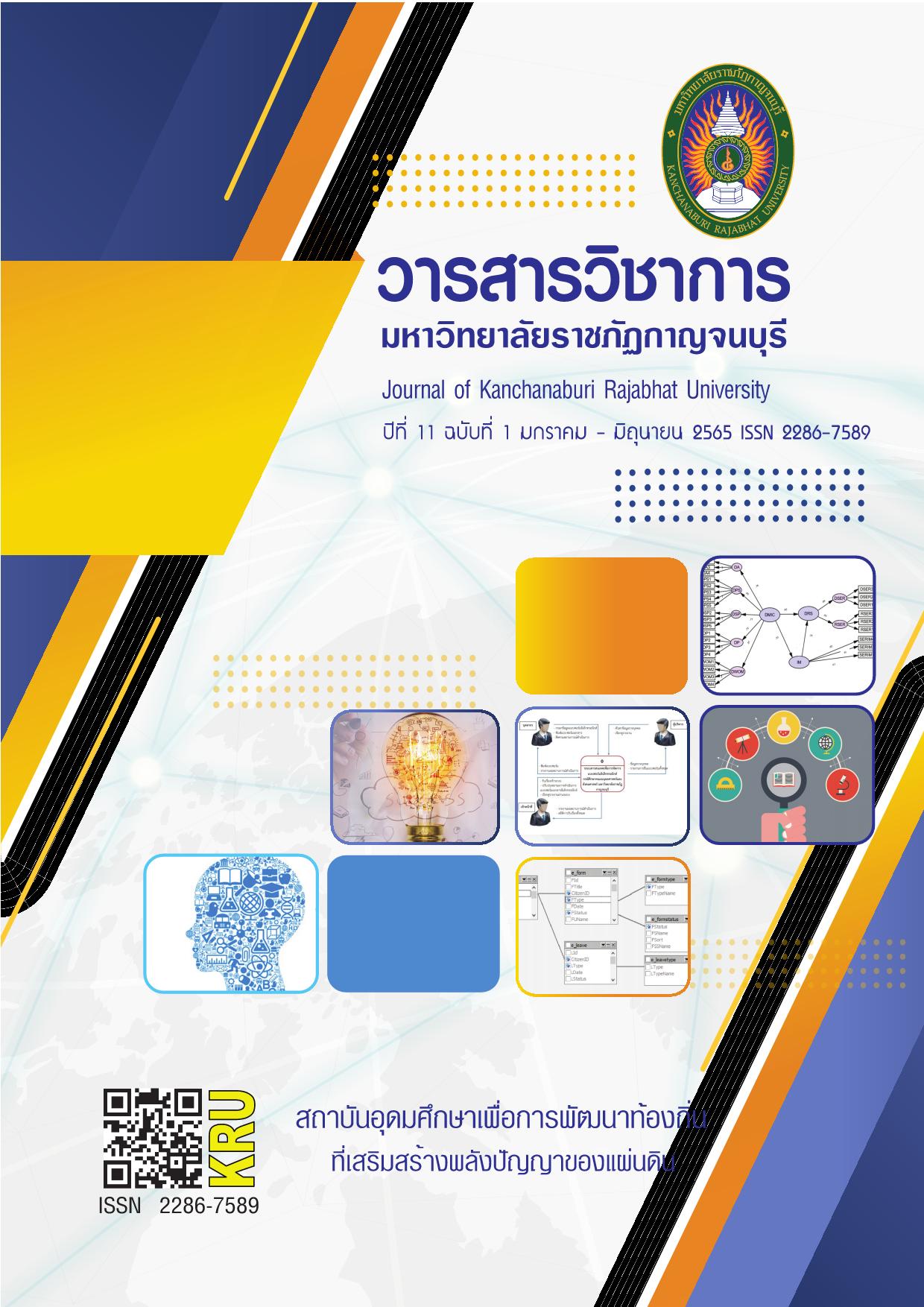ระบบสารสนเทศเพื่อการจัดการแบบฟอร์มอิเล็กทรอนิกส์ กรณีศึกษาคณะมนุษยศาสตร์และสังคมศาสตร์ มหาวิทยาลัยราชภัฏกาญจนบุรี ELECTRONIC FORM MANAGEMENT INFORMATION SYSTEM CASE STUDY OF FACULTY OF HUMANITIES AND SOCIAL SCIENCES KANCHANABURI RAJABHAT UNIVERSITY
Main Article Content
Abstract
The purposes of this research were 1) to develop an electronic form management information system for Faculty of Humanities and Social Sciences, Kanchanaburi Rajabhat University; and 2) to assess the efficiency and satisfaction of the electronic form management information system developed for Faculty of Humanities and Social Sciences, Kanchanaburi Rajabhat University. The system development tools included HTML, PHP and java script language, MySQL database, EditPlus and Adobe Dreamweaver based on relational database design principles. The design and development of the system required users to fill in as little information as possible and employed the connectivity of the current information available in the systems and other databases within the university. The efficiency evaluation and user satisfaction were measured using the Back-Box Testing software and a 5-level rating scale questionnaire. The scores were calculated using mean and Standard Deviation.
The results of the research were as follows: 1) The information system for managing electronic forms for Faculty of Humanities and Social Sciences, Kanchanaburi Rajabhat University could be used according to the objectives of the study. Users were divided into different groups. The operation was implemented via the Internet or Ethernet system within the university through web browser programs such as Internet Explorer, Google Chrome, Mozilla firefox, etc.; 2) For the results of the system performance evaluation by 3 experts, the average score was 4.58, the Standard Deviation was 0.51, and the efficiency of the system was found to be at the highest level. For the satisfaction of the 3 groups of users consisting of 10 people, the average score was 4.34, the Standard Deviation was 0.49, and the satisfaction level was at a high level.
Article Details

This work is licensed under a Creative Commons Attribution-NonCommercial-NoDerivatives 4.0 International License.
References
ดลญา แก้วทับทิม และนาถรพี ตันโช. (2563). ภาพลักษณ์ตราสินค้าและการสื่อสารทางการตลาดแบบครบวงจรที่มีผลต่อการตัดสินใจซื้อ
น้ำดื่มของผู้บริโภคในเขตกรุงเทพมหานคร. วารสาร RMUTT Global Business and Economics Review, 15(1), 58-74.
เดอะสแตนดาร์ด. (2564). ผ่าสงครามน้ำดื่มวิตามิน แบรนด์ใหญ่ลงสนามดุเดือด แต่ใครจะชนะศึกนี้?. ค้นเมื่อ
สิงหาคม 17, 2564, จาก https://thestandard.co/dissecting-the-war-vitamins-drinking-water-who-win.
พงษ์จิรัฐ จึงนิธิเกียรติ และธรรมวิมล สุขเสริม. (2560). การตัดสินใจซื้อผลิตภัณฑ์น้ำดื่มของผู้บริโภคในเขตอำเภอ
เมือง จังหวัดมุกดาหาร. วารสารวิชาการมหาวิทยาลัยอีสเทิร์นเอเชีย ฉบับสังคมศาสตร์และมนุษยศาสตร์, 7(2), 82-92.
ภาณุพันธ์ ขวัญวงษ์ และธนกร น้อยทองเล็ก. (2559). ส่วนประสมการตลาดที่มีอิทธิพลต่อการตัดสินใจซื้อน้ำดื่ม
บรรจุขวดของผู้ประกอบการในเขตอำเภอเถิน จังหวัดลำปาง. วารสารเทคโนโลยีภาคใต้, 9(1), 61-67.
เลิศลักษณ์ จันดาพรหม และอนุวัติ ศรีแก้ว. (2557). พฤติกรรมการเลือกซื้อและความพึงพอใจที่มีต่อส่วนประสมทาง
การตลาด ของผู้บริโภคน้ำดื่มเชิงดอย ในอำเภอเมือง จังหวัดพะเยา. วารสารบัณฑิตวิจัย, 5(2), 101-116.
ศูนย์วิจัยกสิกรไทย. (2564). น้ำดื่มผสมวิตามิน เซกเมนต์ใหม่…บุกตลาดเครื่องดื่ม. ค้นเมื่อ สิงหาคม 14, 2564,
จาก https://kasikornresearch.com/th/analysis/k-social-media/Pages/Vitamin-Water-FB-150920.aspx.
Cochran, W.G. (1977). Sampling Techniques. 3d ed. New York: John Wiley and Sons Inc.
Lema, L., & Negash, M. (2018). Factors affecting brand choice of the consumers on bottled water
brands. Pacific Business Review International, 11(3), 7-17.
Kotler, P. and Armstrong, G., (2018). Principles of marketing. 17th ed. Harlow: Pearson.
Walter, C. T., Kooy, M., & Prabaharyaka, I. (2017). The role of bottled drinking water in achieving
SDG 6.1: An analysis of affordability and equity from Jakarta, Indonesia. Journal of Water,
Sanitation and Hygiene for Development, 7(4), 642-650.


